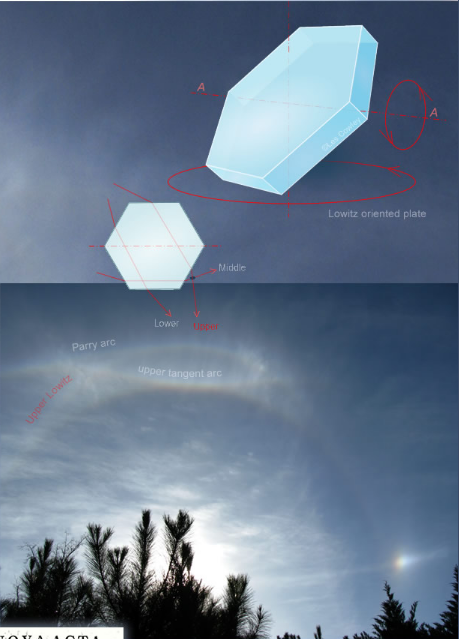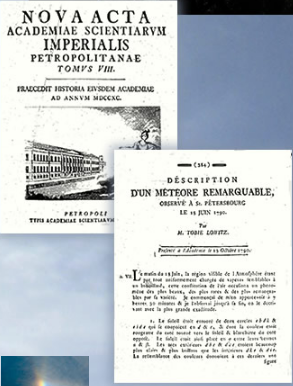OPOD - Lowitz Display, Georgia, USA
OPOD - Lowitz Display: A Rare Atmospheric Phenomenon in Georgia, USA
Have you ever witnessed a rare and captivating atmospheric display? On January 21st, 2013, Tom Faber had the incredible opportunity to witness a spectacle known as the Lowitz Display in Alpharetta, Georgia. This was Tom's second encounter with this elusive phenomenon, the first being an awe-inspiring experience. During this particular display, he was able to observe a series of atmospheric optical phenomena, including sundogs, a 22° halo, upper tangent arc, a Parry arc, a circumzenithal arc, part of the parhelic circle with a faint 120° parhelia, and an upper Lowitz arc. Let's delve deeper into the fascinating world of the Lowitz Display and explore the science behind it.
Understanding Lowitz Arcs
Lowitz arcs are a rare and sought-after atmospheric optical phenomenon. They are often observed as short arcs that extend from sundogs and meet the 22-degree halo. However, the best location to search for these arcs is between the upper tangent and Parry arcs. The upper Lowitz arc extends upwards from the 22-degree halo, crosses the tangent arc, and finally becomes tangent to the Parry arc. To increase your chances of spotting a Lowitz arc, it is advisable to search this specific area when the sun is moderately high in the sky and a Parry arc is visible.
The Legacy of Johann Tobias Lowitz
The discovery of Lowitz arcs can be attributed to Johann Tobias Lowitz, a prominent figure in the field of chemistry. Born in Göttingen in 1757, Lowitz moved to St Petersburg at the age of ten with his father, who was also an Academician. He later accompanied his father on an expedition to the Caspian Sea, where they were both captured by rebels. While Tobias managed to escape, his father tragically lost his life. Despite these hardships, Lowitz continued his studies in Göttingen before returning to Russia.
Lowitz's contributions to the field of chemistry were significant. He established various fundamental laboratory methods and was the first to produce anhydric ethanol, a remarkable achievement that required ingenuity. His expertise in chemical synthesis led him to prepare numerous compounds. However, it is ironic that his name is now primarily associated with his observation of the enigmatic and elusive ice halos in the skies of Petersburg on June 18, 1790.
Unraveling the Enigma of Lowitz Arcs
The Lowitz Display continues to captivate scientists and enthusiasts alike due to its mysterious nature. These ice halos are formed by the interaction of sunlight with ice crystals in the atmosphere. The exact mechanism behind the formation of Lowitz arcs is still not fully understood, adding to their intrigue. Researchers continue to study these atmospheric phenomena, hoping to shed light on their intricate formation process.
Capturing the Beauty of Lowitz Arcs
Photography plays a crucial role in documenting and studying atmospheric optics, including the Lowitz Display. Tom Faber's photographs from his encounter in Alpharetta, Georgia, serve as valuable records of this rare event. Through these images, we can appreciate the intricate details of the atmospheric phenomena, from sundogs to the 22-degree halo and the elusive Lowitz arcs. Photographs not only allow us to marvel at the beauty of these optical displays but also enable scientists to analyze and understand their characteristics more effectively.
The Significance of Atmospheric Optics
Atmospheric optics encompasses a wide range of optical phenomena that occur in the Earth's atmosphere. These phenomena include rainbows, halos, sundogs, and many others. Studying these occurrences provides valuable insights into the physics and chemistry of the atmosphere, as well as the properties of light. By understanding the behavior of light in different atmospheric conditions, scientists can gain a deeper understanding of our planet's climate, weather patterns, and even the composition of the atmosphere itself.
The Thrill of Atmospheric Discoveries
Encountering rare atmospheric phenomena like the Lowitz Display is a thrilling experience. These occurrences remind us of the complexity and beauty of our natural world. They serve as a testament to the intricate interplay between light, particles, and atmospheric conditions. While some optical displays are relatively common, others, like the Lowitz arcs, remain elusive and difficult to witness. As scientists and enthusiasts continue to explore the skies, each new discovery brings us closer to unraveling the mysteries of atmospheric optics.
In conclusion, the Lowitz Display is a rare and captivating atmospheric phenomenon that graced the skies of Alpharetta, Georgia. This elusive display consists of a series of optical phenomena, including sundogs, a 22-degree halo, upper tangent arc, a Parry arc, a circumzenithal arc, part of the parhelic circle with a faint 120-degree parhelia, and an upper Lowitz arc. Johann Tobias Lowitz, a renowned chemist, first reported these arcs in 1794. The science behind the formation of Lowitz arcs remains enigmatic, adding to their allure. Through photography and scientific exploration, we continue to unravel the mysteries of atmospheric optics, gaining a deeper understanding of our planet's atmosphere and its optical wonders. Witnessing these rare displays reminds us of the intricacies and beauty of the natural world and fuels our curiosity to explore further into the realms of atmospheric optics.

Rare Lowitz Arc, Alpharetta, Georgia
Tom Faber experienced his second display (the first) of rare Lowitz arcs on 21st January '13. "Between 3:00-3:30PM EST I saw sundogs, a 22° halo, upper tangent arc, a Parry arc, a circumzenithal arc, part of the parhelic circle with a faint 120° parhelia and an upper Lowitz arc! ©Tom Faber, shown with permission.

Lowitz arcs are often most sought as short arcs extending from sundogs to meet a 22 degree halo. There is a hint of those in the images at right.
However, a much better search location is between upper tangent and Parry arcs. The upper Lowitz arc extends upwards from the 22 degree halo, crosses the tangent arc and finally becomes tangent to the Parry.
Always search this area when the sun is moderately high and a Parry arc is visible.
Johann Tobias Lowitz was the first to report these arcs in a publication of the St Petersburg Imperial Academy of Sciences 1794 where he was Professor of Chemistry.
The Academy, founded by Peter the Great, was a major intellectual centre with many eminent European scientists and other scholars.
Lowitz was born in G�ttingen in 1757 and moved at the age of ten to St Petersburg with his father who was also an Academician. At age 17 he accompanied his father on an expedition to the Caspian Sea where both were captured by rebels. Tobias escaped but his father was killed.
He subsequently studied back in G�ttingen before returning to Russia.
His chemical studies established many basic laboratory methods, he was the first to produce anhydric ethanol � a task requiring some ingenuity � and he prepared many compounds.
It is ironic that after years of practising chemical research he is now best known for his observation in the skies of Petersburg on June 18, 1790 of what has proven to be one of the most enigmatic and elusive of the ice halos.

Note: this article has been automatically converted from the old site and may not appear as intended. You can find the original article here.
Reference Atmospheric Optics
If you use any of the definitions, information, or data presented on Atmospheric Optics, please copy the link or reference below to properly credit us as the reference source. Thank you!
-
<a href="https://atoptics.co.uk/blog/opod-lowitz-display-georgia-usa/">OPOD - Lowitz Display, Georgia, USA</a>
-
"OPOD - Lowitz Display, Georgia, USA". Atmospheric Optics. Accessed on November 21, 2024. https://atoptics.co.uk/blog/opod-lowitz-display-georgia-usa/.
-
"OPOD - Lowitz Display, Georgia, USA". Atmospheric Optics, https://atoptics.co.uk/blog/opod-lowitz-display-georgia-usa/. Accessed 21 November, 2024
-
OPOD - Lowitz Display, Georgia, USA. Atmospheric Optics. Retrieved from https://atoptics.co.uk/blog/opod-lowitz-display-georgia-usa/.